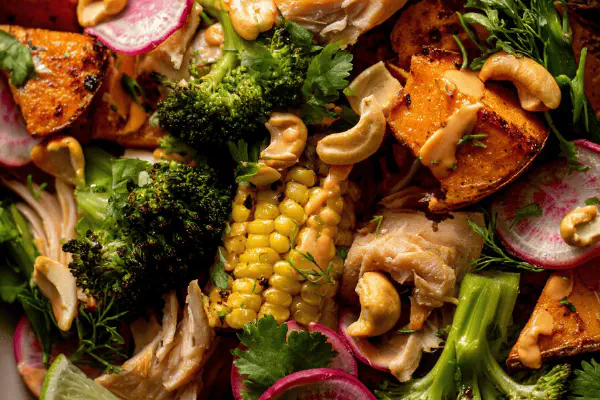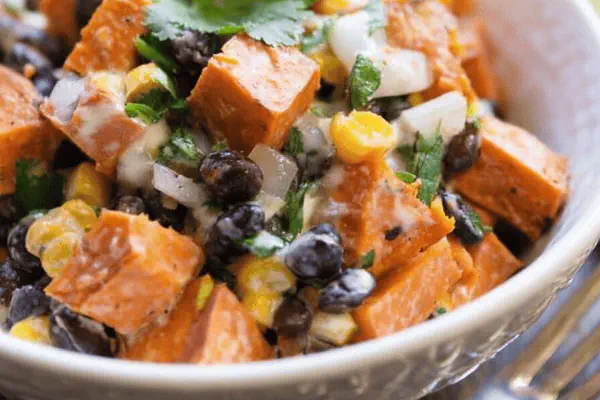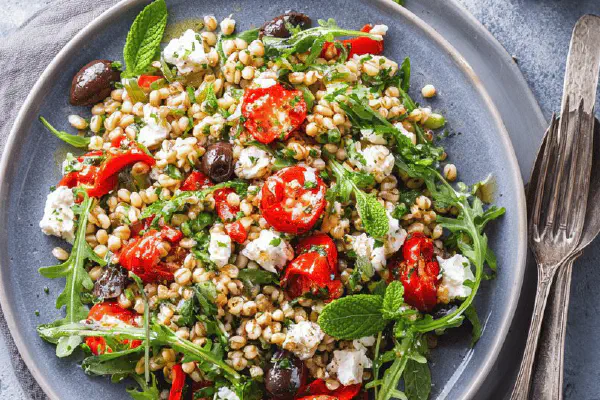Roasted Sweet Potato Broccoli Salad

By Emma
Certified Culinary Professional
Ingredients
- 3 medium sweet potatoes cut into large chunks
- 25 ml vegetable or sunflower oil
- 180 g broccoli florets, chopped small
- 150 g fresh asparagus tips (blanched)
- 6 radishes quartered then thinly sliced
- 3 scallions, thinly sliced
- 60 ml spicy Thai tamarind sauce or homemade nuoc-cham
- 150 g shredded leftover turkey or rotisserie chicken
- Spicy chipotle mayonnaise or sriracha mayo, to taste
- 40 g fresh basil leaves with stems
- 50 g roasted cashews roughly chopped
- 1 large lemon, quartered
About the ingredients
Method
- Set oven rack center. Preheat oven to about 205 °C (400 °F). Toss sweet potato chunks with oil, salt, and cracked black pepper on baking pan lined with parchment or foil.
- Roast sweet potatoes about 18-20 minutes. Flip once halfway through, looking for golden caramelized spots plus tender give when poked with fork. If potatoes brown too fast, lower temp slightly. Remove when edges crisped but interior soft.
- While sweet potatoes roast, lightly blanch broccoli and asparagus in rapidly boiling salted water for 1-1.5 minutes until just vibrant and tender-crisp. Cool quickly under cold water to stop cooking and preserve color.
- In medium bowl, combine broccoli, asparagus, corn kernels (fresh or thawed and drained), sliced radishes, and scallions. Pour over tamarind or nuoc-cham sauce and toss gently. Allow to marinate 12-15 minutes. Stir once or twice. Sauce should coat but not drown.
- Drain vegetables well. Add shredded turkey or chicken. Mix again gently to incorporate. This layering of heat and acidity wakes up the poultry.
- On serving plates spread roasted sweet potatoes first, warm or cooled slightly. Drizzle chipotle or sriracha mayo over potatoes — amount depends on personal tolerance for heat and creaminess.
- Top with marinated vegetable salad. Sprinkle chopped cashews and fresh basil leaves over everything. Use lemon wedges to squeeze vibrant tartness just before eating.
- Note roasting times can vary depending on potato size and oven calibration. The sign to stop roasting? Skin slightly blistered, flesh yielding but not mushy. Marinate veggies just enough so they absorb some sharpness but maintain crunch.
- This salad is flexible — asparagus swapped in for corn adds fresh green sweetness; cashews swapped for pepitas or mild peanuts for different nut oils and flavors. Basil can be substituted with mint or cilantro for a twist. Leftover poultry saves time but roast chicken or turkey from deli also works.
- Avoid soggy veggies by draining well after marinate before combining. Leftover mayo can be thinned with lime juice or vinegar if too thick. Toast cashews for nutty aroma if desired.
Cooking tips
Chef's notes
- 💡 Keep skin on sweet potatoes for rustic texture and nutrients. Scrub well, don’t peel unless allergy or mushy preference. Roast at 205 °C, watch edges brown and crisp but inside soft. Flip once, listen for subtle sizzle changes, smell caramel, poke with fork to check tenderness. Too dark? Lower heat slightly. Too pale? Raise temp or extend time.
- 💡 Blanch broccoli and asparagus briefly, one minute tops. Too long, lose crunch and bright green, too short, raw bite. Immediately plunge in ice water. Color locks, cooking stops dead, texture snaps back. Draining well prevents watery salad later. Corn optional, fresh or thawed and drained. Mix quickly but gently with tamarind or nuoc-cham. Let sit just enough to coat without sogginess; 12-15 mins works.
- 💡 Shredded poultry folded in after vegetables drain completely, layering heat and acidity without watering down texture. Use leftover turkey or rotisserie chicken – flexible here. Mayo drizzle last, keep it sparse—too much overwhelms crispness and freshness. Chipotle or sriracha mayo both work but beware spicy threshold; mild can mix in if you want control.
- 💡 Use lemon wedges last second, squeeze right on plate before eating to avoid limp salad. Adjust mayo thickness if too thick with lime juice or vinegar. Toast cashews separately until dark golden, smell nutty oily aroma, snap when cool. Swap nuts if needed: pepitas, peanuts, even sunflower seeds for allergy or flavor variation. Fresh herbs change mood: basil, mint, cilantro. Keep dry until serving.
- 💡 Roasting temperature and timing varies wildly; small potatoes roast faster, watch for spots shriveling and crisping before entire chunk soft. Flip and check softness with fork. Signs to stop roasting: skin blistered, slightly shriveled, tender give inside, not mushy or gray. Marinate veggies for zing, avoid soaking too long or they lose texture. Drain well before adding poultry to prevent soggy salad.
Common questions
How to know when sweet potatoes are done?
Edges blisters, some brown spots, soft inside but not falling apart. Poke chunk with fork, slight resistance not crunch. Smell caramelizing sugars, sizzle slows down. Flip halfway for even roast. Adjust temp if burning outside early.
Can I swap vegetables?
Yes, corn or asparagus swap easily. Broccoli can be replaced by other tender-crisp stuff but timing changes with density. Blanchtime critical to avoid limp texture. Radishes and scallions add sharp crunch but can omit or change. Herbs flexible too, change basil for mint or cilantro depending on flavor approach.
What if salad gets soggy?
Drain veggies fully after marinating, this avoids watering down later ingredients. Shred poultry dry, mix gently. Mayo can thin out with lemon or vinegar if too thick but avoid mixing too early or too much moisture. Toast nuts fresh and add last minute to keep crunch intact.
How to store leftovers?
Keep components separate if possible. Roast potatoes reheat better than cold, can microwave or briefly oven-warm. Salad stays fresher refrigerated for 1-2 days but loses crunch fast. Mayo or sauce mixed late helps with texture retention. Lemon wedges keep fresh flavor but squeeze only before eating to avoid limpness.



